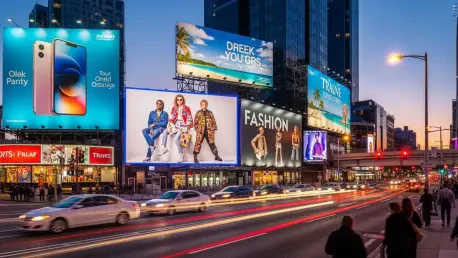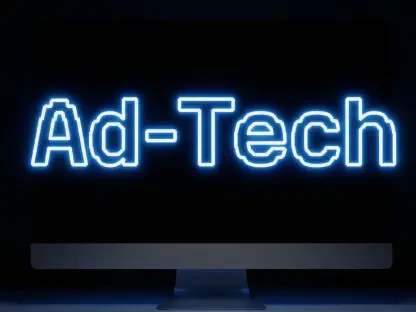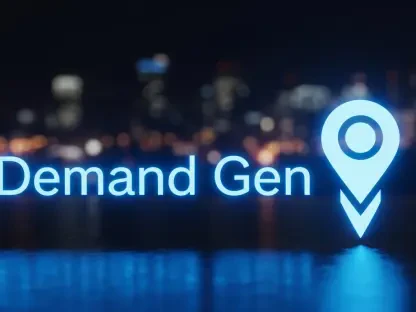Imagine walking down the Las Vegas Strip, surrounded by the dazzling lights and bustling energy of over 40 million annual visitors, when a synchronized visual spectacle unfolds across towering LED displays on pedestrian bridges. This is no longer just a vision but a reality with the Vegas Strip Tower Network, a cutting-edge digital out-of-home (DOOH) advertising and communications system launched by Spotlight Outdoor Ads. Strategically positioned along Las Vegas Boulevard, this network of 13 high-resolution display towers—potentially expanding to 20—promises to transform how brands engage with audiences and how public safety messages reach the masses in one of the world’s most iconic tourist destinations. This review dives deep into the technology behind the network, evaluating its features, performance potential, and broader implications for urban advertising infrastructure.
Core Components and Innovative Design
The Vegas Strip Tower Network stands out as a pioneering DOOH platform, integrating advanced technology with strategic urban placement. Developed through a public-private partnership with Caesars Entertainment, Showcase Mall, and Clark County, the system comprises 13 LED display towers located on pedestrian bridges at key intersections along the Strip. Each tower, measuring 12 feet wide by 27 feet tall, is engineered for maximum visibility, targeting both pedestrian and vehicular traffic in a high-traffic corridor known for its vibrant atmosphere.
Beyond its scale, the network’s design reflects a thoughtful blend of aesthetics and functionality. The towers are seamlessly integrated with elevator columns on pedestrian bridges, leveraging existing infrastructure to minimize construction impact while ensuring structural integrity. Vision Sign, a key collaborator, has prioritized durability, crafting displays to withstand the harsh desert climate, including extreme heat and high winds, all while adhering to strict county regulations. This robust engineering ensures that the displays remain operational and visually striking under challenging conditions.
What sets this network apart is its ability to operate as a cohesive unit. Unlike traditional standalone billboards, these towers can display synchronized content across multiple locations, creating a unified visual experience for advertisers. This capability, powered by Trust Fall’s sophisticated content management system, allows for real-time updates and coordinated campaigns, making the network a dynamic tool for brand storytelling in a city synonymous with spectacle.
Technical Specifications and Performance
High-Resolution Synchronized Displays
At the heart of the network’s appeal is its synchronized LED display system, designed to deliver content simultaneously across all towers. Each display boasts a 6-millimeter pixel pitch, ensuring high-resolution imagery that remains clear and vibrant even in the bright Las Vegas sunlight. This technical specification strikes an optimal balance between visual quality and cost-efficiency, providing sharp content for close-range pedestrian viewing without unnecessary expense.
The synchronization feature is a game-changer for advertising campaigns. Managed through Trust Fall’s advanced software, the system enables brands to launch seamless messages or promotions across the Strip, amplifying impact through consistency and scale. Whether it’s a product launch or a city-wide event, the ability to update content in real time ensures relevance and engagement, positioning the network as a leader in dynamic outdoor media.
Performance-wise, early assessments suggest the displays meet the high standards required for such a prominent location. With an estimated one million impressions per tower weekly, the network capitalizes on the Strip’s massive foot traffic to deliver unparalleled exposure. This metric underscores the system’s potential to redefine how advertisers measure reach and effectiveness in premium urban environments.
Structural Integrity and Environmental Adaptation
The physical design of the towers is equally impressive, reflecting meticulous attention to engineering challenges. Each unit is built to endure the environmental rigors of the desert, from scorching temperatures to sudden wind gusts, thanks to Vision Sign’s expertise in outdoor display construction. The integration with pedestrian bridge structures not only saves space but also enhances safety by avoiding standalone installations that could pose hazards in crowded areas.
Visibility is another critical factor addressed by the design. Positioned at eye level for pedestrians and within sightlines for drivers, the towers maximize exposure without obstructing pathways or violating local guidelines. This strategic placement ensures that content reaches a diverse audience, from tourists exploring on foot to commuters passing through the Strip’s busy intersections.
Compliance with county regulations further highlights the project’s commitment to balancing innovation with responsibility. By meeting stringent structural and safety standards, the network demonstrates how technology can enhance urban spaces without compromising public welfare, setting a benchmark for similar initiatives in other high-traffic locales.
Market Context and Industry Alignment
The Vegas Strip Tower Network emerges at a time when DOOH advertising is experiencing significant growth globally. Industry projections indicate that global spending on DOOH will reach $19 billion this year, with an expected rise to over $25 billion by 2029. This upward trend reflects a growing appetite for digital solutions that offer flexibility and impact in advertising, particularly in densely populated or tourist-heavy areas like Las Vegas.
A notable shift in the industry is the increasing adoption of programmatic advertising, which automates the buying and placement of ads using data-driven platforms. This trend toward automation aligns perfectly with the network’s capabilities, as its real-time content management system lays the groundwork for future programmatic integration. Such advancements could allow advertisers to target specific demographics or times of day, enhancing efficiency and return on investment.
Additionally, the network taps into the premium DOOH trend of synchronized, multi-functional systems. By combining commercial advertising with public safety features like emergency messaging, it addresses both economic and civic needs, mirroring a global push for infrastructure that serves multiple purposes. This alignment with cutting-edge industry movements positions the network as a frontrunner in shaping the future of outdoor media.
Real-World Applications and Broader Impact
The primary application of the Vegas Strip Tower Network lies in its capacity as a high-impact advertising platform. With the ability to generate massive impressions in a short time frame, it offers brands an unmatched opportunity to connect with a diverse, transient audience of leisure and business travelers. The synchronized displays amplify this effect, creating a cohesive brand presence that stands out amid the Strip’s sensory overload.
Beyond commerce, the network serves a vital role in public safety through its emergency messaging capabilities. In a crisis, real-time communication can be broadcast across all towers, ensuring critical information reaches visitors and residents swiftly. This functionality transforms the system into a lifeline during emergencies, adding a layer of societal value that elevates its significance beyond traditional advertising tools.
Another practical feature is the inclusion of dedicated wayfinding screens on each tower. These displays provide navigational assistance and public interest content without encroaching on advertising space, improving the visitor experience while maintaining revenue potential. This thoughtful addition benefits tourists unfamiliar with the area and supports local authorities in managing crowd flow, showcasing how technology can enhance urban navigation.
Challenges in Deployment and Operation
Despite its promise, the network faces several hurdles in implementation. Regulatory coordination in a high-profile area like the Las Vegas Strip presents complexities, as securing permits and aligning with county policies requires extensive collaboration. Any delays or missteps in this process could impact the phased rollout, which began with three towers this fall and aims to reach six by year-end.
Technical challenges also loom large, particularly in maintaining display performance under extreme weather conditions. While the design prioritizes durability, ensuring consistent synchronization across towers in real time demands robust network reliability and backup systems. Any glitches in content delivery could undermine advertiser confidence, making ongoing maintenance and monitoring essential.
Market dynamics pose additional obstacles, with premium pricing for ad space potentially limiting accessibility for smaller brands. Competition with other advertising mediums, such as traditional billboards and digital screens inside casinos, adds pressure to demonstrate superior value. Addressing these issues through strategic pricing models and phased deployment optimization will be critical to sustaining momentum and market share.
Future Prospects and Scalability
Looking ahead, the Vegas Strip Tower Network is on a promising trajectory with a phased rollout planned through 2026, targeting completion of the initial 13 towers and potential expansion to 20. This gradual approach allows for real-world testing and refinement, ensuring each phase builds on lessons learned to enhance overall performance and impact.
Future integrations, such as programmatic advertising capabilities, could further elevate the network’s appeal by enabling precise audience targeting and automated ad placements. Such advancements would align with global DOOH trends, positioning the system as an adaptable platform capable of evolving with market demands and technological progress.
Long-term, the network has the potential to serve as a model for other major tourist destinations seeking to balance commercial advertising with civic responsibilities. Its success could inspire similar projects in cities worldwide, demonstrating how synchronized digital infrastructure can transform urban communication while generating economic benefits. Monitoring its progress over the coming years will provide valuable insights into the scalability of such ambitious endeavors.
Reflecting on a Groundbreaking Initiative
Looking back, the launch of the Vegas Strip Tower Network marked a pivotal moment in the evolution of DOOH advertising, blending innovative technology with strategic urban integration to create a platform of immense potential. Its synchronized displays, dual-purpose functionality, and robust design stood as testaments to what could be achieved through public-private collaboration in a city renowned for pushing boundaries. The early phases of deployment offered a glimpse into its capacity to captivate audiences and support public safety, even as challenges in regulation and technical execution demanded careful navigation.
Moving forward, stakeholders should prioritize seamless coordination among partners to address regulatory and operational hurdles, ensuring the rollout remains on track. Investing in advanced failover systems for network reliability would safeguard against technical disruptions, while exploring flexible pricing models could broaden advertiser access. As the network expands, documenting its impact on visitor experience and brand engagement would provide a roadmap for other cities, cementing its legacy as a trailblazer in digital urban infrastructure.









